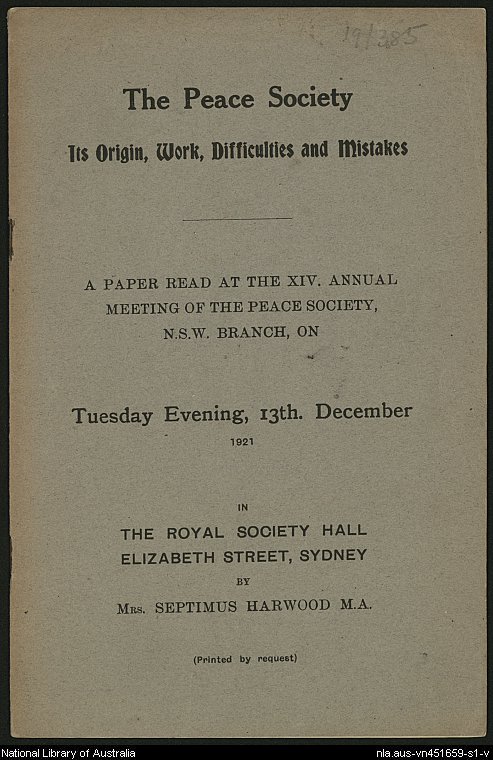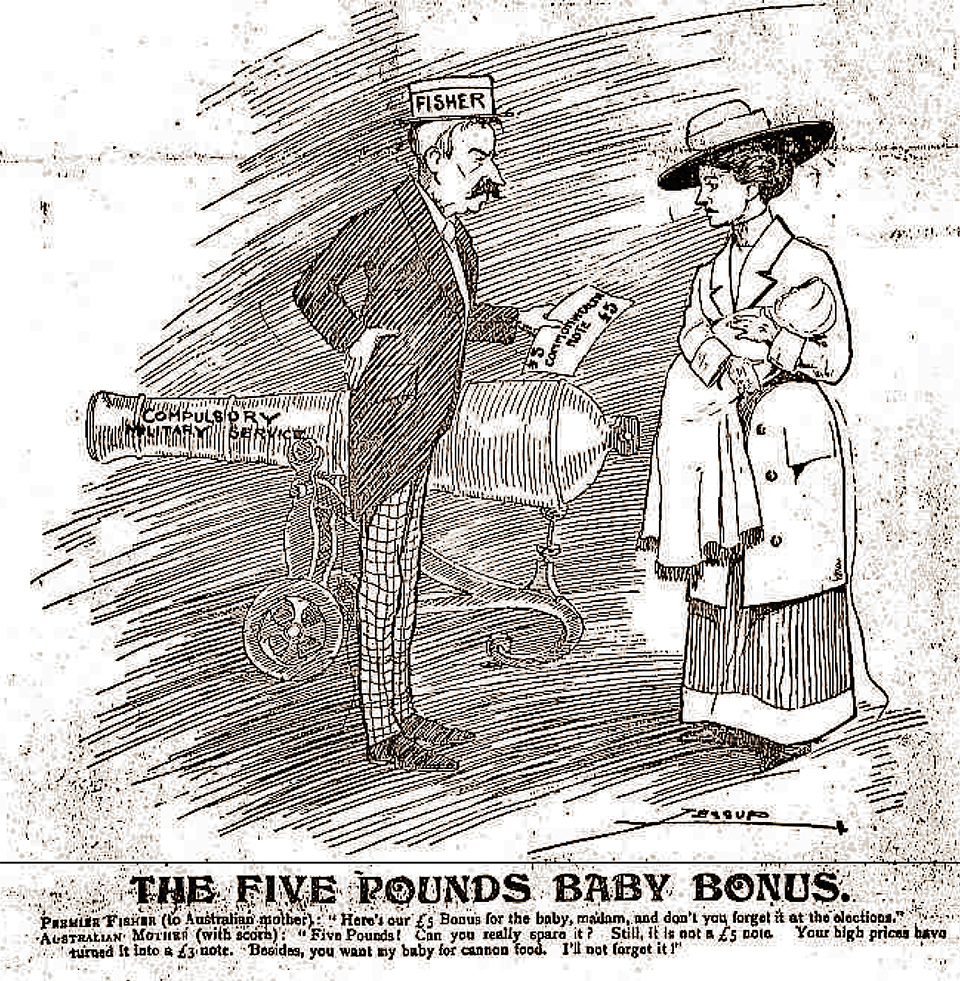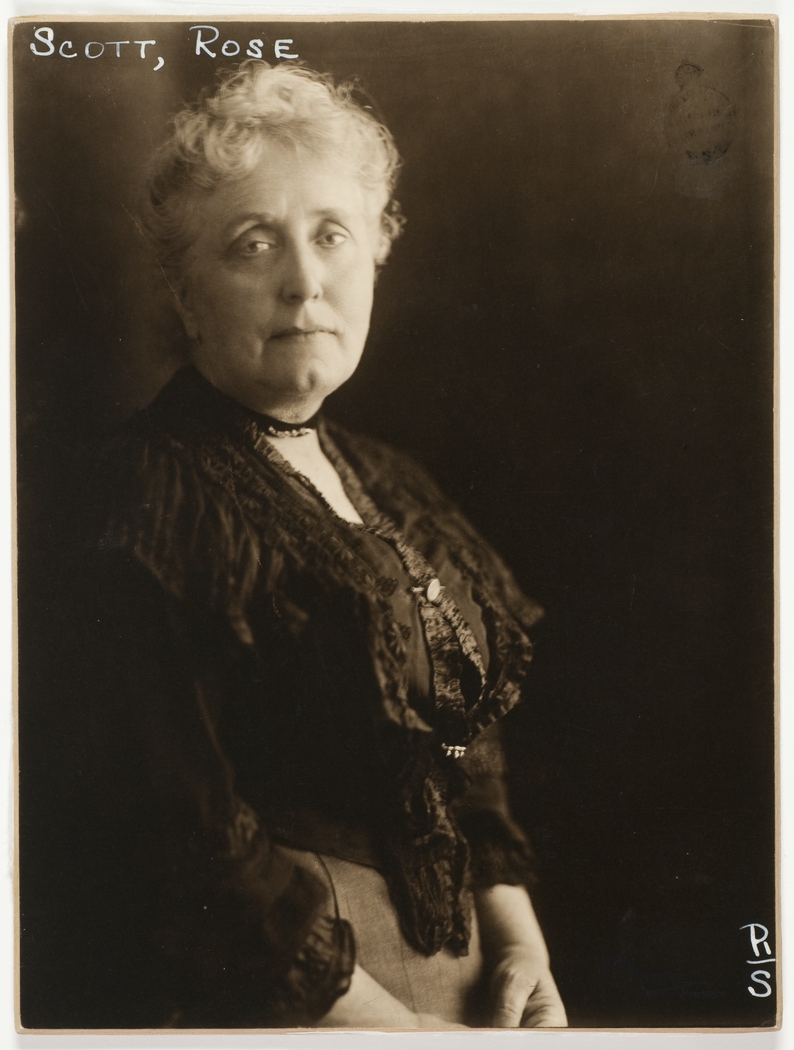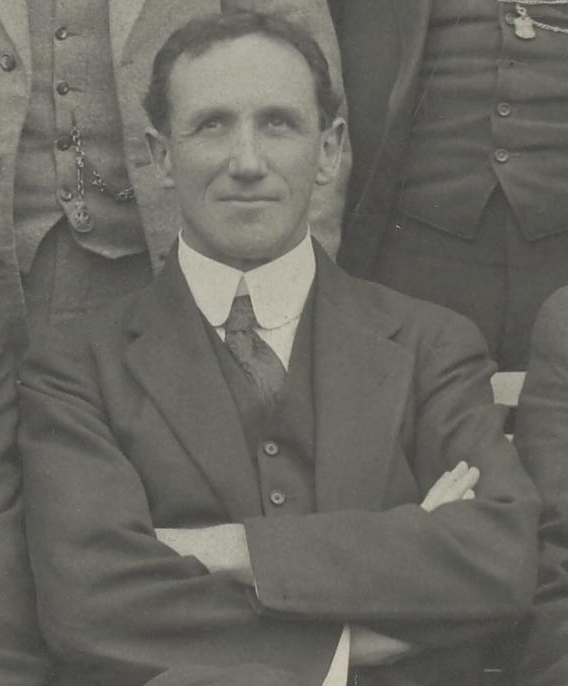The Dictionary of Sydney was archived in 2021.
World War I and the Peace Society in Sydney
Citation
Persistent URL for this entry
To cite this entry in text
To cite this entry in a Wikipedia footnote citation
To cite this entry as a Wikipedia External link
World War I and the Peace Society in Sydney
[media]Sydney was a city very much divided by Australia's involvement in World War I. Loyalty to the British Imperial Empire was increasingly challenged by the nationalist belief in putting 'Australia first'. Calls for liberty and freedom in Europe were experienced under strict wartime legislation. Rampant patriotic jingoism jostled roughly with calls for peace while some pacifists found themselves personally confronted with a complete change of mind once war broke out.
The conscription referendums of 1916 and 1917 bitterly split the population into 'pros' or 'antis' and the public campaigns conducted in the weeks leading up to voting day were often violent and ugly. In Sydney, living conditions grew steadily difficult as prices climbed and wages did not catch up. As the horrors of the war progressed, Australian losses in Europe mounted. With grief and sadness everywhere, industrial unrest was ever present and class conflict remained rife. Juxtaposed with an increasingly repressive state that sought to suppress freedom of speech and action, Sydney was at times a volatile and envenomed city.
The New South Wales branch
The New South Wales branch of the Peace Society was founded in 1907 when a preliminary meeting of Quakers and other prominent citizens was held on 29 September in the Devonshire Street Meeting House. The next meeting was held on 26 November 1907 in the School of Arts, Pitt Street, when the Society was formally organised. The feminist and prominent political activist, Rose Scott, was Chair and Mr William Arthur Holman (who would later become the Premier of New South Wales) was the chief speaker. [1] Members were mostly educated middle class and included academics, politicians, doctors, clergymen, feminist activists and teachers. Unfortunately, it is impossible to know how many members there were in the early days as membership records were not kept. [2]
There were four main aims of the Peace Society based on the tenets of nineteenth century liberal internationalism: the adoption of arbitration in all international disputes instead of war; the simultaneous reduction of armaments to relieve the people of the world of the increasing burden of taxation; the removal of international misunderstandings and the cultivation of international brotherhood and goodwill; and cooperation with kindred societies in Australasia, Great Britain and Ireland, and other countries throughout the world.
Between 1912 and 1916 the Society published Pax : The Monthly Organ of the Peace Society that members could subscribe to. It included local articles of interest, extracts from foreign peace societies, quotes, peace poetry and meeting reports. [3] An extensive library of peace literature was established and monthly meetings were held at Marian Fleming Harwood's rooms at 1 Bond Street, Sydney. [4] As President from 1907 to 1917, Rose Scott played an active part in lecturing on peace in the suburbs of Sydney and from her own house in Woollahra. She also frequently led deputations to the minister of education, urging that peace by arbitration be taught in the schools of New South Wales rather than the violent militant histories that were then in vogue. Both before and during World War I, Scott awarded prizes for peace essays written by the pupils of Sydney schools. [5] This was a popular activity and '…many essays were sent in, most of them excellent.' [6]
[media]Immediately prior to World War I, the Peace Society became involved with the issue of compulsory military training. In 1911 the Australian Government had legislated that all youths between the ages of 12 and 26 were required to train for varying periods each year in the citizen forces. [7] Failure or refusal to perform this compulsory training was subject to heavy fines and/or imprisonment. This scheme of 'compulsory militarism for vote-less lads' was fiercely opposed by many including the Peace Society, New South Wales Baptist Union, Quakers, religious pacifists, socialists and indeed hundreds of parents and boys. [8] The Peace Society naturally deplored this compulsory act for its complete disregard of freedom of conscience and for the waste of millions of dollars spent 'in that mesh of military expenditure'. [9] For others opposed to the scheme 'this dreadful leap in the dark' was seen to be oppressive, unnecessary and a violation of the principle of volunteerism; it also threatened civil rights and religious liberties as it held few provisions for the conscientious objector. [10] Others opposed it on the grounds that the age of 12 was too young to inculcate in 'their susceptible souls the brutalising apprenticeship in prospective slaughter'. [11]
In 1912, the Australian Freedom League (AFL) was established to oppose conscription and to secure the repeal of the compulsory clauses of the Defence Act. By 1914, it had a membership of 55,000. [12] During the first three years of the schemes operation, 27,749 prosecutions were launched against parents for failing to register their sons and 5,732 youths were imprisoned in military prisons and civilian jails for refusing to present themselves for training. [13] Clearly there was opposition to compulsory military service among the community prior to World War I. The issue would again become prominent in 1916 and 1917.
When Britain and Australia entered World War I in August 1914, the AFL quietly suspended all campaigning activities and all discussion on compulsory military training ceased. To do otherwise would have been deemed disloyal in the early days of the war. On 8 August 1914, the New South Wales branch of the AFL adopted a resolution stating that '…desiring not to hamper the Government in the discharge of their grave responsibility, [the ALF] resolve to suspend active operations for the time being.' [14]
In a similar vein, the Peace Society did not openly and vocally oppose the war on its outbreak. Rather, they decided to 'appeal to all their members to send anything they can spare, so that we may be able to do our little part towards helping to relieve local distress'. [15] By November 1914, £43 had been collected and put into a trust fund. The Society was confident that the war would make no difference in the publication or readership of Pax:
On the contrary, we have reason to believe that it will increase the circulation, as already we have got several new subscribers. Even the most militant spirits are beginning to realise and acknowledge that arms will never lead to peace, and that we must appeal to reason and justice rather than to force. [16]
[media]This was, however, rather optimistic; subscriptions did fall and every month until it ceased publication in 1916, readers were constantly and sharply reminded that their subscriptions were overdue. The annual meeting in November 1914 was poorly attended and many members left the Society convinced that the war was, in fact, a just war. As Marian Harwood later lamented:
Some of our old members then deserted us, carried away by the prevalent idea that this particular war was so exceptionally righteous and just and necessary that they dared no longer preach peace. 'Fair Weather' Pacifists of this type break down every time there is a war. As a rule they said nothing, did not resign, but simply retired and left us in the lurch. Such were Mr WA Holman, Rev Dr Roseby, Dr McCarthy and others, also a valued Hon. Secretary, who did explain that she was very sorry, but that she considered to remain a pacifist then meant disloyalty to King and Country, so we had with regret to accept her resignation. [17]
[media]It is said that supporting peace and pacifism in peacetime is noble, virtuous and realistic. Yet it is very different to supporting peace and pacifism in wartime. Between 1914 and 1918, political, pacifist and patriotic tensions between the Society's members fractured this once united group. Rose Scott tried to consider the war as an international problem while Marian Harwood used her position as the editor of Pax to publish views much more sympathetic to the actions of Germany. This caused these two strong-willed women to clash frequently at committee meetings. It also caused the censors, who regularly interrupted Harwood's mail, to view her as 'a formidable opponent of the status quo'. [18]
[media]Some members, such as Dr Charles William McCarthy, wholeheartedly supported the war and resigned their committee positions. The Quaker William Benson also supported the war and conceded that in some circumstances the use of force was justified. The Reverend Thomas Roseby had joined the committee of the Peace Society in 1909. In 1916, he resigned as vice-president, conflicted in his beliefs; he was still a convinced pacifist but also convinced that conscription ought to be introduced. Others left the Peace Society altogether: William A Holman had long been active in the peace movement and was a founding member of the Peace Society of New South Wales yet he supported Australia's involvement in the war and, as the Labour Premier, stood firmly in the 'yes' camp during the conscription referendums. [19]
The question of how the peace might be won also caused incredible frictions and factions within the Peace Society. In May 1917, the Society committed itself to campaigning for peace by negotiation yet Rose Scott vehemently opposed this on the grounds 'that Germany, the aggressor cannot be trusted; the rulers of Germany are like criminal lunatics'. [20] In November 1917, Scott resigned as President of the Society as her different stance on the war and its peaceful conclusion meant she no longer represented the views of the majority of the committee. She remained vice-president until her death in 1925 but she lost many of her personal friends for her pacifist, anti-militarist and anti-conscription views during the war. [21] Shortly afterwards, Constance Bonney also resigned as secretary, convinced that the Peace Society was deluded in its call for peace by negotiation. [22]
The many wartime tensions between members of the New South Wales Peace Society was, in microcosm, one small example of the way in which the war split and deeply divided people. World War I desiccated the small and once coherent group of members of the Peace Society; it also split and divided Sydneysiders in similar ways.
References
John Barrett, Falling In: Australians and ,'Boy Conscription,' 1911–1915 (Sydney: Hale and Iremonger, 1979)
Joan Beaumont, Broken Nation: Australians in the Great War (Sydney: George Allen and Unwin, 2013)
James Bennett, Rats and Revolutionaries: The Labour Movement in Australia and New Zealand 1890–1940 (Dunedin, New Zealand: University of Otago Press, 2004)
Verity Burgmann and Jenny Lee (eds), Staining the Wattle: A People,'s History of Australia since 1788 (Fitzroy, Vic: McPhee Gribble, 1988)
Frank Cain, The Wobblies at War: A History of the IWW and the Great War in Australia (Victoria: Spectrum Publications, 1993)
Charles Manning Hope Clark, New South Wales and Van Diemen,'s Land, vol 6, A History of Australia (London; New York: Cambridge University Press, 1987)
Joy Damousi and Marilyn Lake (eds) Gender and War: Australians at War in the Twentieth Century (Cambridge, UK; New York; Melbourne: Cambridge University Press, 1995)
Eric Fry (ed), Rebels and Radicals (Sydney: George Allen and Unwin, 1983)
Mrs Septimus Harwood, 'The Peace Society: Its Origins, Work, Difficulties and Mistakes' (paper read at the 14th Annual Meeting of the Peace Society, NSW Branch, Royal Society Hall, Elizabeth Street, Sydney December 13, 1921)
John F Hill, 'Vigour', Child Conscription, Our Country,'s Shame (Adelaide: Burmeister and Co, 1912)
Leslie Cyril Jauncey, The Story of Conscription in Australia (London: Allen and Unwin, 1935; reissued Melbourne: MacMillan, 1968)
Marilyn Lake, Mark McKenna and Henry Reynolds, What,'s Wrong With Anzac? The Militarisation of Australian History (Sydney: UNSW Press, 2010)
Michael McKernan, Australian Churches at War: Attitudes and Activities of the Major Churches 1914–1918 (Sydney and Canberra: Catholic Theological Faculty and Australian War Memorial, 1980)
Michael McKernan, The Australian People and the Great War (Sydney: Collins, 1980)
Eleanor M Moore, The Quest for Peace: As I Have Known It In Australia (Melbourne: Wilke and Co Ltd, 1948–49)
The Peace Society, Pax: The Monthly Organ of the Peace Society
Australian Workers' Union, The Worker
Sydney Labour History Group, What Rough Beast? The State and Social Order in Australian History (North Sydney: George Allen & Unwin, 1982)
Notes
[1] William Arthur Holman was a founding member of the Anti-War League in Sydney that in 1902 opposed Australian involvement in the Boer War. For the peace movement before World War I see Ann-Mari Jordens, 'Against the Tide: The Growth and Decline of a Liberal Anti-War Movement in Australia, 1905–1918' in Historical Studies 22, no 88 (April, 1987): 373–94; Chris Healy, 'War Against War' in Verity Burgmann and Jenny Lee (eds), Staining the Wattle: A People,'s History of Australia since 1788 (Fitzroy, Vic: McPhee Gribble, 1988) 208–27
[2] In 1921 Marian Harwood suggested that over a hundred members had come and gone between 1907 and 1921. Mrs Septimus Harwood, 'The Peace Society: Its Origins, Work, Difficulties and Mistakes' (paper read at the 14th Annual Meeting of the Peace Society, NSW Branch, Royal Society Hall, Elizabeth Street, Sydney December 13, 1921), 3
[3] In the May and June 1916 edition of Pax: The Monthly Organ of the Peace Society, Harwood announced that for the present Pax would cease publication owing to her own ill health ; see Marian Harwood Pax: The Monthly Organ of the Peace Society 44 (May, 1916): 35 and Marian Harwood Pax: The Monthly Organ of the Peace Society 45 (June, 1916): 35
[4] Harwood would play a prominent role in the Peace Society until her death in 1934. See Ann-Mari Jordens, 'Marian Harwood' in Heather Radi (ed), Two Hundred Australian Women: A Redress Anthology, (Sydney: Women's Redress Press Inc. 1988), 47–48
[5] Pax: The Monthly Organ of the Peace Society 28 (November, 1915): 23
[6] Mrs Septimus Harwood, 'The Peace Society: Its Origins, Work, Difficulties and Mistakes' (paper read at the 14th Annual Meeting of the Peace Society, NSW Branch, Royal Society Hall, Elizabeth Street, Sydney, December 13, 1921), 5
[7] The Defence Act of 1911; see John Barrett, Falling In: Australians and ,'Boy Conscription,' 1911–1915 (Sydney: Hale and Iremonger, 1979), Leslie Cyril Jauncey, The Story of Conscription in Australia (London: Allen and Unwin, 1935; reissued Melbourne: MacMillan, 1968), 36–62
[8] William Robert Winspear was just one outspoken critic of the scheme. A socialist and a newspaper editor, he abhorred 'boy conscription' and war and wrote vehemently against the 'leprosy of militarism'. For more on Winspear, see Verity Burgmann, 'The Mightier Pen, William Robert Winspear' in Eric Fry (ed), Rebels and Radicals (Sydney: George Allen and Unwin, 1983) 163–77; Verity Burgmann, 'Winspear, William Robert (1859–1944),' Australian Dictionary of Biography, National Centre of Biography, Australian National University, http://adb.anu.edu.au/biography/winspear-william-robert-9155/text16163, published in hardcopy 1990, viewed 27 February 2014
[9] '5th Annual Report for November 1912', Pax: The Monthly Organ of the Peace Society 7 (15 February, 1913): 6
[10] John F Hill, 'Vigour', Child Conscription, Our Country,'s Shame (Adelaide: Burmeister and Co, 1912); 'To My Fellow Countrymen', note on back of cover page. The Act did provide that conscientious objectors might be exempt from bearing arms but they were still expected to perform non-combative duties. For a contemporary account of opposition to the scheme see John Percy Fletcher and John Francis Hills, Conscription Under Camouflage: An Account of Compulsory Military Training in Australasia Down to the Outbreak of The Great War (South Australia: Co-Operative Printing and Publishing Company 1919). This book was written in 1915 and it was fiercely opposed to the military training of Australian youths. Because of the war, it was not published until 1919. In that year, John Fletcher was serving a two-year sentence as a conscientious objector under the English Military Services Act
[11] John F Hill, 'Vigour', Child Conscription, Our Country's Shame (Adelaide: Burmeister and Co, 1912), 13
[12] In 1912, the Peace Society considered joining with it but decided that individual members would be free to join the League. Pax: The Monthly Organ of the Peace Society (15 July, 1912): 9
[13] See Malcolm Saunders and Ralph Summy, The Australian Peace Movement: A Short History (Canberra: ANU, 1986), 17; Francis Barrymore Smith, The Conscription Plebiscites in Australia, 1916–17 (Melbourne: Victorian Historical Association), fourth Edition, revised 1974, 6; Leslie Cyril Jauncey, The Story of Conscription in Australia (London: Allen and Unwin, 1935; reissued Melbourne: MacMillan, 1968), 63–102
[14] Leslie Cyril Jauncey, The Story of Conscription in Australia (London: Allen and Unwin, 1935; reissued Melbourne: MacMillan, 1968), 103. In 1915 a few former members of the Australian Freedom League formed the Australian Peace Alliance which quickly established itself in four states and spent the rest of the war calling for a negotiated peace
[15] Loose telegram found inside Pax: The Monthly Organ of the Peace Society 25 (August, 1914)
[16] Pax: The Monthly Organ of the Peace Society 25 (August, 1914): 24
[17] Mrs Septimus Harwood, 'The Peace Society: Its Origins, Work, Difficulties and Mistakes' (paper read at the 14th Annual Meeting of the Peace Society, NSW Branch, Royal Society Hall, Elizabeth Street, Sydney December 13, 1921): 6
[18] Ann-Mari Jordens, 'Anti-War Organisations in a Society at War, 1914–18', in Journal of Australian Studies, 14; 26 (1990): 80
[19] Both the war and the issue of conscription bitterly divided the Labour Party which was already divided by tensions between the industrial (trade unions) and the political wings. See James Bennett, Rats and Revolutionaries: The Labour Movement in Australia and New Zealand 1890–1940 (Dunedin, New Zealand: University of Otago Press, 2004), 73–78; Greg Patmore, Australian Labour History (Melbourne: Longman Cheshire, 1991), 84; Joe Harris, The Bitter Fight: A Pictorial History of the Australian Labor Movement (Brisbane: Queensland University Press, 1970), 226–59 and Francis Barrymore Smith, The Conscription Plebiscites in Australia, 1916–17 (Melbourne: Victorian Historical Association), fourth Edition, revised 1974, 21–24
[20] Ann-Mari Jordens, 'Anti-War Organisations in a Society at War, 1914–18', in Journal of Australian Studies 14, no 26 (1990): 81–82
[21] Ann-Mari Jordens, 'Anti-War Organisations in a Society at War, 1914–18', in Journal of Australian Studies 14, no 26 (1990): 85. See also Judith Allen, Rose Scott: Vision and Revision in Feminism (London: Oxford University Press, 1994), 211–35
[22] Ann-Mari Jordens, 'Anti-War Organisations in a Society at War, 1914–18' in Journal of Australian Studies 14, no 26 (1990): 82
.







